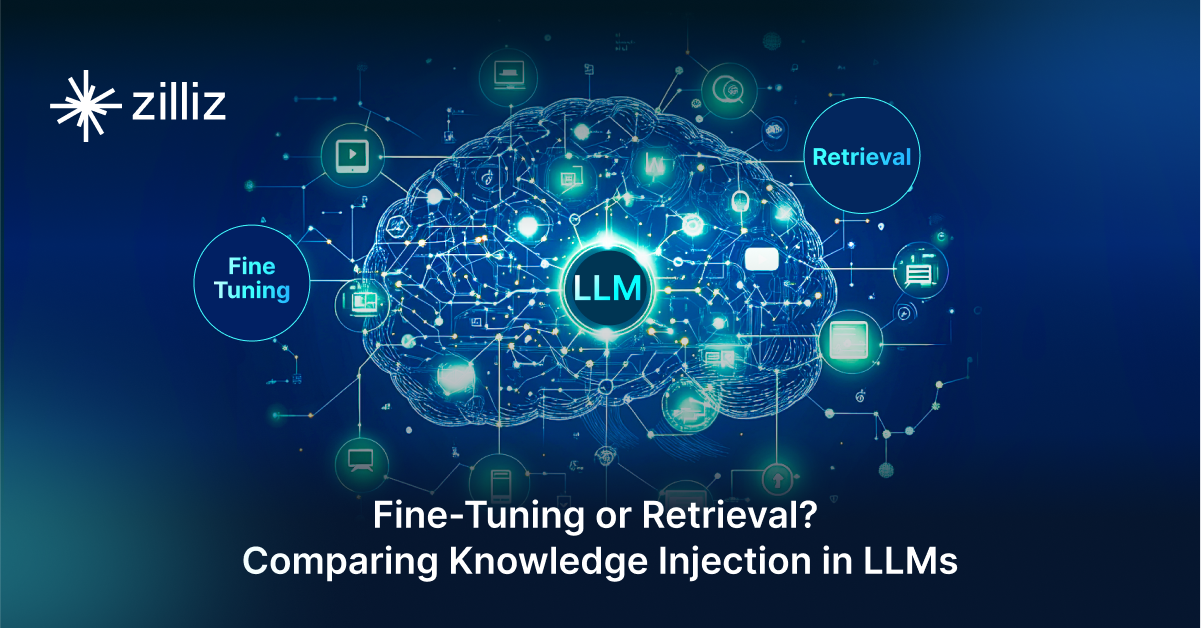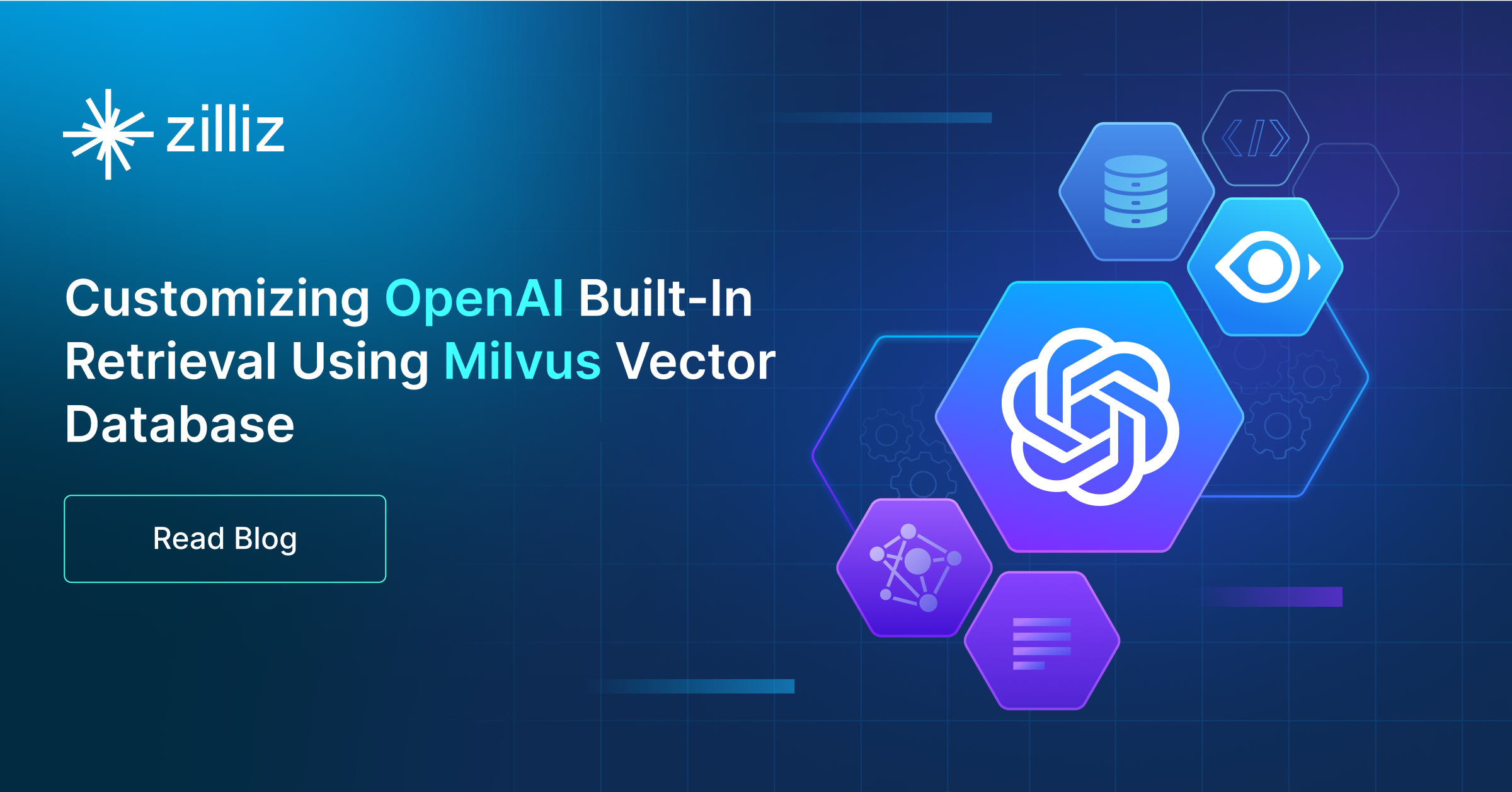Build RAG Chatbot with Llamaindex, Zilliz Cloud, Mixtral 8x7B, and voyage-3
Introduction to RAG
Retrieval-Augmented Generation (RAG) is a game-changer for GenAI applications, especially in conversational AI. It combines the power of pre-trained large language models (LLMs) like OpenAI’s GPT with external knowledge sources stored in vector databases such as Milvus and Zilliz Cloud, allowing for more accurate, contextually relevant, and up-to-date response generation. A RAG pipeline usually consists of four basic components: a vector database, an embedding model, an LLM, and a framework.
Key Components We'll Use for This RAG Chatbot
This tutorial shows you how to build a simple RAG chatbot in Python using the following components:
- Llamaindex: a data framework that connects large language models (LLMs) with various data sources, enabling efficient retrieval-augmented generation (RAG). It helps structure, index, and query private or external data, optimizing LLM applications for search, chatbots, and analytics.
- Zilliz Cloud: a fully managed vector database-as-a-service platform built on top of the open-source Milvus, designed to handle high-performance vector data processing at scale. It enables organizations to efficiently store, search, and analyze large volumes of unstructured data, such as text, images, or audio, by leveraging advanced vector search technology. It offers a free tier supporting up to 1 million vectors.
- Mixtral 8x7B: A sparse mixture-of-experts (MoE) model with eight 7B parameter networks, designed for efficient, high-performance NLP tasks. Excels in text generation, reasoning, and multilingual support while minimizing computational costs. Ideal for scalable enterprise applications, real-time chatbots, and multi-task environments requiring optimized resource utilization and versatile AI capabilities.
- Voyage-3: Designed for AI-powered navigation and journey planning, Voyage-3 optimizes route efficiency while providing real-time traffic updates and data insights. Its strengths lie in predictive analysis and adaptive learning, making it ideal for logistics, delivery services, and travel apps that demand reliable and intelligent navigation solutions.
By the end of this tutorial, you’ll have a functional chatbot capable of answering questions based on a custom knowledge base.
Note: Since we may use proprietary models in our tutorials, make sure you have the required API key beforehand.
Step 1: Install and Set Up Llamaindex
pip install llama-index
Step 2: Install and Set Up Mixtral 8x7B
%pip install llama-index-llms-mistralai
from llama_index.llms.mistralai import MistralAI
llm = MistralAI(model="open-mixtral-8x7b")
Step 3: Install and Set Up voyage-3
%pip install llama-index-embeddings-voyageai
from llama_index.embeddings.voyageai import VoyageEmbedding
embed_model = VoyageEmbedding(
voyage_api_key="",
model_name="voyage-3",
)
Step 4: Install and Set Up Zilliz Cloud
pip install llama-index-vector-stores-milvus
from llama_index.core import VectorStoreIndex, StorageContext
from llama_index.vector_stores.milvus import MilvusVectorStore
vector_store = MilvusVectorStore(
uri=ZILLIZ_CLOUD_URI,
token=ZILLIZ_CLOUD_TOKEN,
dim=1536, # You can replace it with your embedding model's dimension.
overwrite=True,
)
Step 5: Build a RAG Chatbot
Now that you’ve set up all components, let’s start to build a simple chatbot. We’ll use the Milvus introduction doc as a private knowledge base. You can replace it with your own dataset to customize your RAG chatbot.
import requests
from llama_index.core import SimpleDirectoryReader
# load documents
url = 'https://raw.githubusercontent.com/milvus-io/milvus-docs/refs/heads/v2.5.x/site/en/about/overview.md'
example_file = 'example_file.md' # You can replace it with your own file paths.
response = requests.get(url)
with open(example_file, 'wb') as f:
f.write(response.content)
documents = SimpleDirectoryReader(
input_files=[example_file]
).load_data()
print("Document ID:", documents[0].doc_id)
storage_context = StorageContext.from_defaults(vector_store=vector_store)
index = VectorStoreIndex.from_documents(
documents, storage_context=storage_context, embed_model=embed_model
)
query_engine = index.as_query_engine(llm=llm)
res = query_engine.query("What is Milvus?") # You can replace it with your own question.
print(res)
Example output
Milvus is a high-performance, highly scalable vector database designed to operate efficiently across various environments, from personal laptops to large-scale distributed systems. It is available as both open-source software and a cloud service. Milvus excels in managing unstructured data by converting it into numerical vectors through embeddings, which facilitates fast and scalable searches and analytics. The database supports a wide range of data types and offers robust data modeling capabilities, allowing users to organize their data effectively. Additionally, Milvus provides multiple deployment options, including a lightweight version for quick prototyping and a distributed version for handling massive data scales.
Optimization Tips
As you build your RAG system, optimization is key to ensuring peak performance and efficiency. While setting up the components is an essential first step, fine-tuning each one will help you create a solution that works even better and scales seamlessly. In this section, we’ll share some practical tips for optimizing all these components, giving you the edge to build smarter, faster, and more responsive RAG applications.
LlamaIndex optimization tips
To optimize LlamaIndex for a Retrieval-Augmented Generation (RAG) setup, structure your data efficiently using hierarchical indices like tree-based or keyword-table indices for faster retrieval. Use embeddings that align with your use case to improve search relevance. Fine-tune chunk sizes to balance context length and retrieval precision. Enable caching for frequently accessed queries to enhance performance. Optimize metadata filtering to reduce unnecessary search space and improve speed. If using vector databases, ensure indexing strategies align with your query patterns. Implement async processing to handle large-scale document ingestion efficiently. Regularly monitor query performance and adjust indexing parameters as needed for optimal results.
Zilliz Cloud optimization tips
Optimizing Zilliz Cloud for a RAG system involves efficient index selection, query tuning, and resource management. Use Hierarchical Navigable Small World (HNSW) indexing for high-speed, approximate nearest neighbor search while balancing recall and efficiency. Fine-tune ef_construction and M parameters based on your dataset size and query workload to optimize search accuracy and latency. Enable dynamic scaling to handle fluctuating workloads efficiently, ensuring smooth performance under varying query loads. Implement data partitioning to improve retrieval speed by grouping related data, reducing unnecessary comparisons. Regularly update and optimize embeddings to keep results relevant, particularly when dealing with evolving datasets. Use hybrid search techniques, such as combining vector and keyword search, to improve response quality. Monitor system metrics in Zilliz Cloud’s dashboard and adjust configurations accordingly to maintain low-latency, high-throughput performance.
Mixtral 8x7B optimization tips
To optimize Mixtral 8x7B in RAG, prioritize efficient context retrieval by fine-tuning chunk size and overlap for balanced relevance and latency. Use sparse attention configurations to reduce computational overhead, and enable tensor parallelism to leverage its mixture-of-experts architecture. Quantize the model to 4-bit precision (e.g., via GPTQ) for faster inference with minimal accuracy loss. Pre-filter retrieved documents to remove noise, and cache frequent query embeddings. Adjust temperature (0.2-0.5) and max tokens to balance creativity and focus. Profile expert routing to ensure balanced workload distribution across GPU resources.
voyage-3 optimization tips
voyage-3 is a versatile model suitable for balanced performance in RAG systems, making efficient retrieval strategies crucial for maintaining low latency and high accuracy. Improve retrieval by leveraging embedding-based similarity search with reranking to ensure relevant context is included. Structure prompts with clear context separation and concise instructions to maximize response accuracy. Set temperature between 0.1 and 0.3 for controlled output while tuning top-k and top-p for flexibility. Implement response caching for frequently queried data to minimize redundant processing and API calls. Utilize parallel processing and request batching to optimize resource efficiency. For multi-model deployments, assign voyage-3 to mid-tier complexity tasks while using larger models for deeper analysis and smaller models for real-time, low-latency queries.
By implementing these tips across your components, you'll be able to enhance the performance and functionality of your RAG system, ensuring it’s optimized for both speed and accuracy. Keep testing, iterating, and refining your setup to stay ahead in the ever-evolving world of AI development.
RAG Cost Calculator: A Free Tool to Calculate Your Cost in Seconds
Estimating the cost of a Retrieval-Augmented Generation (RAG) pipeline involves analyzing expenses across vector storage, compute resources, and API usage. Key cost drivers include vector database queries, embedding generation, and LLM inference.
RAG Cost Calculator is a free tool that quickly estimates the cost of building a RAG pipeline, including chunking, embedding, vector storage/search, and LLM generation. It also helps you identify cost-saving opportunities and achieve up to 10x cost reduction on vector databases with the serverless option.
 Calculate your RAG cost
Calculate your RAG cost
What Have You Learned?
Congratulations on completing this tutorial! You've ventured into the fascinating world of Retrieval-Augmented Generation (RAG) systems, and what an incredible journey it’s been! Throughout the tutorial, you've seen how to harness the power of LlamaIndex as a robust framework, coupled with the expertise of Zilliz Cloud as a state-of-the-art vector database. You learned how to feed information efficiently into the Mixtral 8x7B LLM, enabling it to generate rich, context-aware responses. With the embedding model tying everything together, you've equipped yourself with a comprehensive understanding of how these components interact to provide seamless performance and meaningful insights.
But that’s not all! We also shared valuable optimization tips to fine-tune your RAG pipeline for the best possible outcomes, and you were shown a handy, free RAG cost calculator to keep your project on budget. So, what’s next? The possibilities are truly endless! Now that you have all the knowledge and tools at your fingertips, it’s time to start building, optimizing, and innovating your own RAG applications! Don’t just stop here—dive deeper into this exciting technology and transform your ideas into something amazing. Your adventure in the world of RAG is just beginning, and we can’t wait to see what you’ll create!
Further Resources
🌟 In addition to this RAG tutorial, unleash your full potential with these incredible resources to level up your RAG skills.
- How to Build a Multimodal RAG | Documentation
- How to Enhance the Performance of Your RAG Pipeline
- Graph RAG with Milvus | Documentation
- How to Evaluate RAG Applications - Zilliz Learn
- Generative AI Resource Hub | Zilliz
We'd Love to Hear What You Think!
We’d love to hear your thoughts! 🌟 Leave your questions or comments below or join our vibrant Milvus Discord community to share your experiences, ask questions, or connect with thousands of AI enthusiasts. Your journey matters to us!
If you like this tutorial, show your support by giving our Milvus GitHub repo a star ⭐—it means the world to us and inspires us to keep creating! 💖
- Introduction to RAG
- Key Components We'll Use for This RAG Chatbot
- Step 1: Install and Set Up Llamaindex
- Step 2: Install and Set Up Mixtral 8x7B
- Step 3: Install and Set Up voyage-3
- Step 4: Install and Set Up Zilliz Cloud
- Step 5: Build a RAG Chatbot
- Optimization Tips
- RAG Cost Calculator: A Free Tool to Calculate Your Cost in Seconds
- What Have You Learned?
- Further Resources
- We'd Love to Hear What You Think!
Content
Vector Database at Scale
Zilliz Cloud is a fully-managed vector database built for scale, perfect for your RAG apps.
Try Zilliz Cloud for Free


